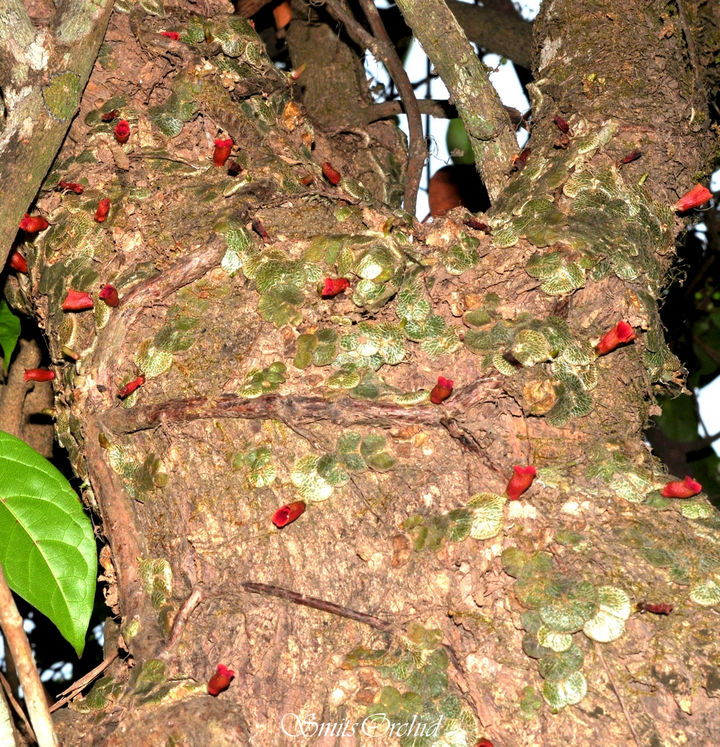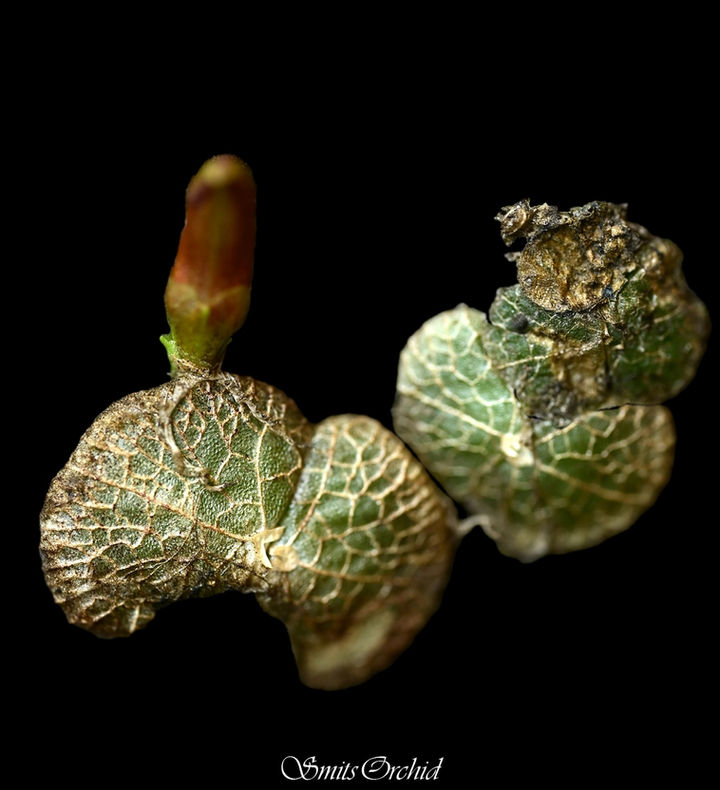
Porpax Lindl.
Sub Family: Epidendroideae
Tribe: Podochilae
Sub tribe: Eriinae
Derivation of Name: From porpax,handle of shield referring either to the shape of pseudobulb or pair of small oblong leaves arising from pseudobulbs which are recurved at their points
Salient Features:
-
Dwarf epiphytic or lithophytic herb forming mat on substrate rhizome creeping; pseudobulb with one internode ovoid or spherical dorsoventrally compressed covered by sheath that disintegrate into reticulate network bearing one or two leaves at apex
-
Leaves usually two appearing after or together with flower at the apex of pseudobulb, coriaceous spreading, narrowly elliptical, lanceotae or oblong-ovate acute or obtuse, base tapering to a petiole articulated at the tip of pseudobulb
-
Inflorescence synanthous or proteranthous, terminal from the base or apex of pseudobulb usually braeing single flower, flower bracts conspicuous covering ovary
-
Flower usually solitory sub companulate not widely opening brown dull red or transluscent greenish yellow
-
Sepals usually fused from the base to apex forming tube like flower entirely enclosing petals, column & labellum; Dorsal sepal ovate lateral sepals obliquely ovate, falcate;
-
Petals: shorter than sepals, elliptical to oblong-lanceolate
-
Labellum entire or indistinctly trilobed, recurved ‘V’ shaped in travserse section Column with foot two times longer than column; Anther incumbent; Pollinia 8 in two groups of four, clavate laterally compressed; Stigma concave oval to almost circular; rostellum broad truncate

Porpax reticulata Lindl.
In Edwards's Bot. Reg. 31(Misc.): 62 (1845)
-
Cryptochilus reticulatus (Lindl.) Rchb.f. in Bot. Zeitung (Berlin) 20: 214 (1862)
-
Eria reticulata (Lindl.) Benth. & Hook.f. in Gen. Pl. 3: 509 (1883)
-
Aggeianthus marchantioides Wight in Icon. Pl. Ind. Orient. 5: 18 (1851)
-
Porpax papillosa Blatt. & McCann in J. Bombay Nat. Hist. Soc. 35: 268 (1931)

Ecology: Epiphytic orchid found growing on Careya arborea, Memceylon umbellatum, Terminalia billirica & Syzygium sp. in moist evergreen forest
Pseudobulbs 2 cm across orbicular, whitish green, covered with white reticular lacy sheaths
Shoot: 0.5x0.2cm slightly dialated at the base, sheathed, sheaths membranous light brown crisped, broadly oblong-sub orbicular, acute entire minutely papillate, gland dotted many nerved

Leaves: 2, very small at flowering, about 5x3mm. Mature leaves become obovate, entire acute with minute blackish mucro, both surfaces of leaf are papillate when young, papillae disappear in mature leaves

Flower: arises from below pseudobulb from tube like structure formed by young sheaves & sheaths around it, flower is solitary, deep brown-red in colour, tubular, shortly pedicellate, pedicel with ovary 3-4mmlong deep brownish red
Bract: 6x7mm pale dirty brown, membranous, sub orbicular, retuse, irregularly denticulate, gland dotted 1 nerved

Sepals: fused to form sub companulate tube, 14x8mm deep brown red, saccate at the base3 lobed at the apex, densely & minutely papillose inside. Lobes broadly ovate rounded mucronate
Petals: spathulate sub falcate acute, densely & minutely papillose 3 nerved

Labellum 3 lobed panduriform somewhat acute, toothed at the base, shortly clawed, tooth about 2mm long subulate acute, entire rounded at the back, shallowly grooved in front. Lateral lobes 3x2mm, broadly triangular, parallel, entire, minutely papillose
Mid lobe broader than long, 2x3mm, suborbicular, irregularly denticulate, densely papillose

Column 2x1mm oblong produced below into foot, clinandrium square with two longitudinally parallel ridges

anther 1x1mm broadly oblong apiculate apex seated on top of column articulated back

Pollinia 8 in two groups of 4 each orbicular attached to minute viscidium with short caudicle

Capsule: obovoid- orbicular,10x8mm, pale green, ribbed tumid, stalked

Flowering: April-May
Leaves: June
Fruiting: August-September












